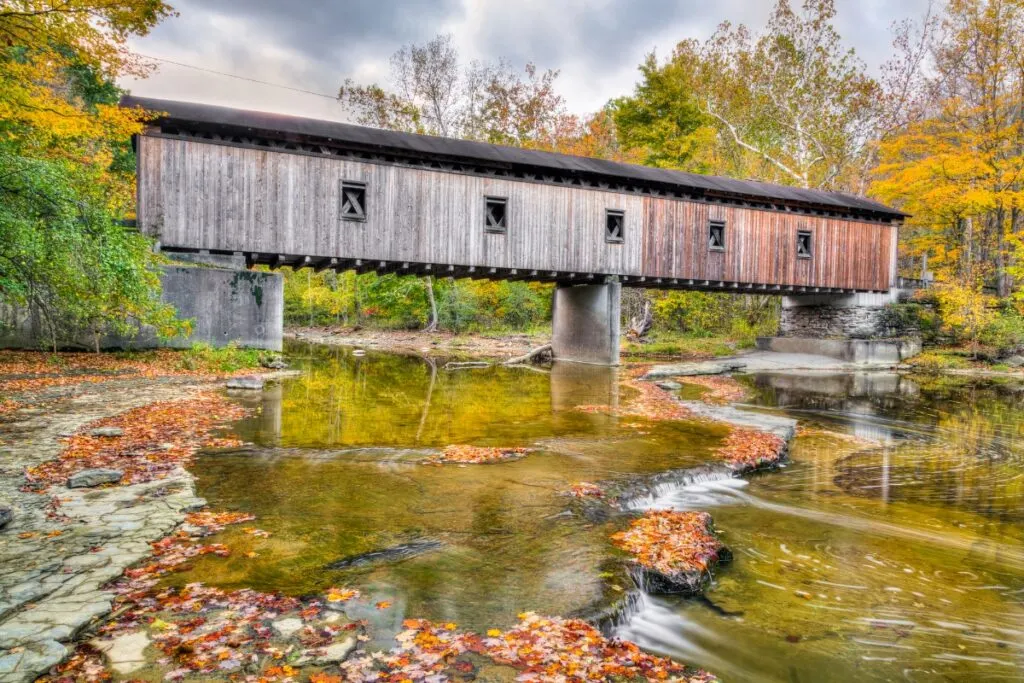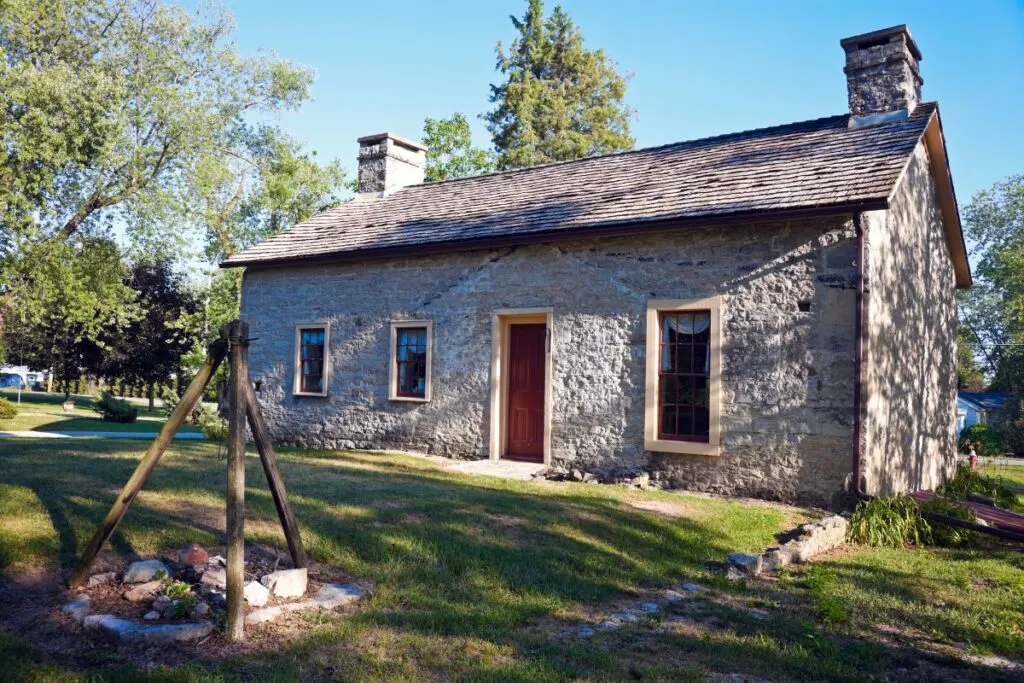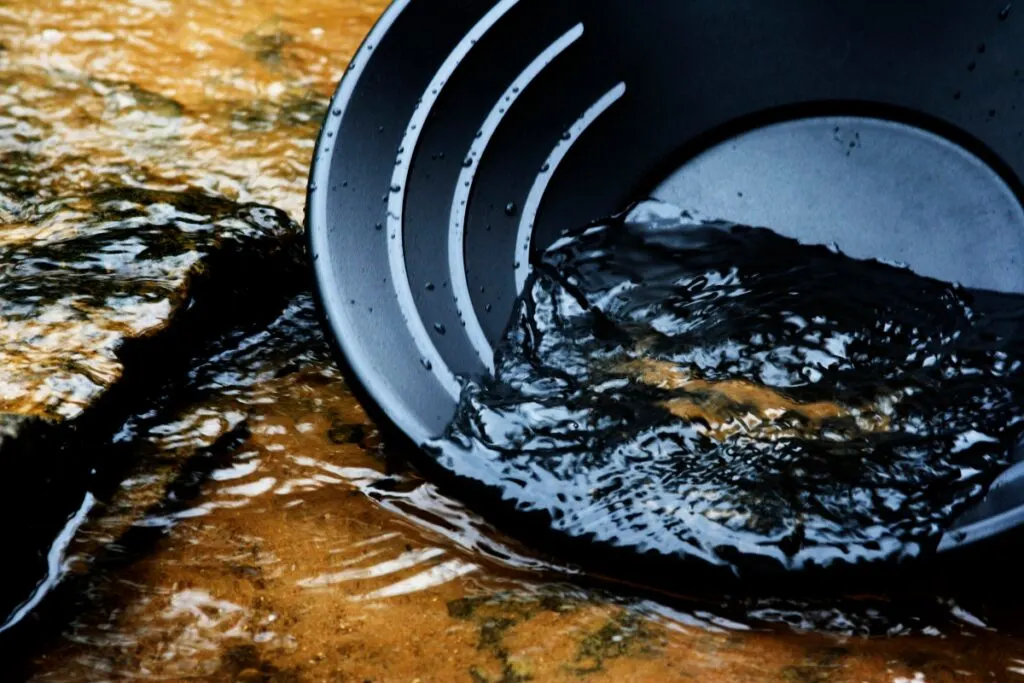As an Amazon Associate, I earn from qualifying purchases with no additional costs for you.
Gold prospecting in Ohio is a wonderful puzzle waiting to be pieced together by explorers like you. As we delve into this intriguing subject, expect the unexpected, a delightful burst of revelations, sparking interest where you least expected.
The best gold prospecting locations in Ohio are:
- Clear Fork River
- Swank Claim
- Scioto River
- Greenville Creek
- Frazee Claim
- Miami River
- Ashtabula River
We’ll guide you through the gold-speckled of Ohio, the hotspots for modern-day gold prospectors, and the most effective techniques to get started in this engaging hobby. We‘ll reveal seven of the best spots to search for this precious metal. Additionally, we’ll demystify the legal aspects of gold prospecting, ensuring your treasure hunt is both fun and law-abiding.

If you want to check out the best tools and equipment for gold prospecting, you can find them by clicking here (Amazon link).
The Legality of Gold Prospecting in Ohio
The Ohio Department of Natural Resources (ODNR) is the state’s grand overseer of mineral extraction. To legally prospect for gold, you’ll need to procure the right permissions from them.
Even though you have a permit, the land you’re prospecting on might have something to say about it.
Private land requires the owner’s consent before you start sieving through their soil. As for public lands, the legality is dictated by the exact type of public land. Not all public lands are open to prospecting!
And then, there’s the matter of environmental laws. Prospecting methods that cause environmental disruption, like hydraulic mining, are frowned upon, to put it mildly. They’re downright illegal. With your trusty gold pan and respectful methods, you’re golden (pun intended).
7 Best Places to Find Gold in Ohio
Hidden treasures still await those willing to seek them out. From rugged landscapes to picturesque rivers, Ohio’s diverse terrain offers many opportunities for gold prospecting enthusiasts. Here are the top 7 best places to find gold in Ohio:
Clear Fork River
The Clear Fork River, Located in the heart of Mohican State Park, Clear Fork River promises a tantalizing treasure hunt. Gold panning in its waters, especially around Butler and Bellville, has been successful for many prospectors.
The Clear Fork River is notorious among prospectors as a gold-rich site. Gold here is typically fine, and often flour gold; the Clear Fork River is famous for gold discoveries; Placer gold is often found in its sediment deposits, and Known for its diverse wildlife and serene ambiance, the Clear Fork River can often play host to an exciting treasure hunt.
Nestled in the rich landscape of Central Ohio, gold particles have been found in its alluvial deposits, making it a favorite spot among gold panning enthusiasts.
Swank Claim
The swank Claim, Run by the Gold Prospectors Association of America (GPAA) on the Kokosing River near Mt. Vernon, offers an excellent opportunity to pan for gold.
You need to be a member to access the claim, but it’s a worthy investment for the golden rewards you might find.
The Swank Claim on the Mohican River, This privately-owned land managed by the Gold Prospectors Association of America (GPAA), is a little golden sanctuary where dreams of striking it rich come to life.
The claim offers rich placers due to its proximity to Bellville, a gold-bearing area. The Swank Claim offers a rich history and a good chance of finding gold. Flour gold and small pickers have been found here regularly, making it a hot spot for prospectors.
Scioto River
The Scioto River, Notorious among gold enthusiasts, runs through Columbus, revealing gold deposits along its path. Remember, gold panning here is best after a good rain when the waters uncover the gleaming wealth from its bed.
Head towards Columbus and Dublin for the best panning locations. The gold found here is usually fine but consistent. The Scioto River winds its way through the central and southern parts of the state, offering beautiful scenery, potential spots for finding gold.
The Scioto River presents quite a few opportunities for prospecting. The gold here can often be found in gravel bars and river bends. The Scioto River, particularly around Kenton, is said to contain gold.
Although finding larger nuggets might be challenging, there’s a fair chance of coming across flour gold.
TIP: Find out my recommended products if you are looking for the best tools you need to find gold (Amazon link):
- Gold Metal Detector: Bounty Hunter TK4 Tracker
- Gold Pan: Stansport Deluxe Gold Pan
- Sluice Box: Stansport Aluminum Sluice Box
- Shovel: Radius Garden Carbon Steel Shovel
- Snuffer Bottle: Stansport Snuffer Bottle
Greenville Creek
The Greenville Creek, Found in Darke County is a tributary of the Stillwater River. The metal was first discovered here in the 1800s, and prospectors have been scouring its waters since then.
Prospectors have reported finding gold in its waters, making it a hot spot for those on the gold trail. This is a great place for beginners due to its easily accessible location and potential for gold discovery.
This creek is a known hotspot for gold. Prospectors have reported findings of small flakes and flour gold. The best spots are where the water slows down or creates eddies.
Frazee Claim
The Frazee Claim, It’s situated near Loudonville in Ohio, located within the broader Clear Fork Reservoir Wildlife Area, providing a great opportunity for prospectors to connect with nature while seeking their fortunes.
This claim offers a unique prospecting experience with gold in various sizes ranging from fine particles to larger flakes.
The gold can often be found in the river gravels and surrounding soil, presenting an exciting challenge for prospectors to master different prospecting techniques.
This location is perfect for novice and experienced prospectors alike and forms a part of Ohio’s vibrant gold prospecting culture.
Miami River
The Miami River, Stretching through the western side of Ohio, is another gold prospector’s delight. You might find the largest concentrations of gold near the city of Troy and the Eldean Covered Bridge.
Stretching across several counties, the Miami River holds a reputation for gold deposits along its course. The Miami River runs from Logan County to Hamilton County, and it’s got some good spots for gold.
The best areas tend to be near the river’s bends or where large rocks create natural riffles. Although panning here may need a bit of patience.
Ashtabula River
The Ashtabula River is Situated in northeastern Ohio; gold prospectors often overlook the Ashtabula River. The Ashtabula River may be considered an underdog in the world of gold prospecting.
Unlike other rivers in Ohio, it doesn’t have a large reputation for gold findings, making it a less crowded option for prospectors.
However, scattered reports have indicated the presence of gold, particularly around the river bends and in the gravel beds.
While the size of gold particles found here is generally on the smaller side, requiring careful extraction techniques, the experience of prospecting in a less pressured environment can be a rewarding venture for both beginner and seasoned gold seekers.
TIP: Simple gold panning is among the most allowed gold prospecting techniques you can use almost anywhere. Check out other effective methods in the article below:
The 7 Most Effective Gold Prospecting Techniques Explained
Active, Old & Abandoned Mines
Let’s explore notable mines throughout Ohio and identify their current status.
Salt Fork State Park Mine (inactive)
The Salt Fork State Park Mine, Located in Guernsey County, has long been a source of coal.
This mine is particularly significant due to its integration with Salt Fork State Park’s natural habitat. As of 2023, mining operations have ceased, and the site has been rehabilitated and incorporated into the park’s natural landscape.
Black Diamonds (Old)
A historically significant region, Southeastern Ohio’s “Little Cities of Black Diamonds” is a series of now-defunct coal mining towns that boomed in the late 19th and early 20th centuries.
Today, these communities share a common heritage, celebrating their history through the annual Little Cities of Black Diamonds Day. While active mining has ceased, these sites offer a fascinating glimpse into Ohio’s mining history.
Marble Cliff Quarry (Old)
The Marble Cliff Quarry supplied much of the limestone used in Columbus’s construction. Operating since the late 19th century, In recent years, there’s been a concerted effort to repurpose the site into a mixed-use development, blending commercial, residential, and public spaces.
TIP: Starting your gold prospecting journey depends on your seriousness and knowledge. Check out the ultimate guide on starting gold prospecting in the article below:
Ultimate Beginner’s Guide: How To Start Gold Prospecting
Gold Prospecting Clubs in Ohio

Gold prospecting clubs can be an excellent way to learn more about gold panning, network with other enthusiasts, and gain access to exclusive prospecting areas. Here are some prominent gold prospecting clubs in Ohio:
Ohio State Prospectors Association (OSPA)
The Ohio State Prospectors Association is another significant player in Ohio’s gold prospecting scene. This non-profit organization aims to educate its members about the ecological impact of prospecting, prioritizing eco-friendly practices.
OSPA organizes regular outings, seminars, and demonstrations to promote responsible gold prospecting.
Founded by a group of dedicated, mineral-loving individuals, OSPA welcomes anyone interested in gold prospecting. The club is known for its educational activities, field trips, and group outings aimed at enhancing the skills and knowledge of its members.
Gold Prospectors Association of America (GPAA)
The Gold Prospectors Association of America, Buckeye Chapter is a prominent force within Ohio’s gold prospecting community. This club stands out with its focus on family-friendly activities, educational outings, and fostering camaraderie among its members.
With its strong affiliation to the GPAA, the Buckeye Chapter provides members access to claims in Ohio and across the country.
The group organizes regular monthly meetings and demonstrations, where members share tips, techniques, and exciting stories of their prospecting adventures.
The club’s vast network, extending beyond Ohio through its affiliation with the national GPAA, offers its members a wealth of resources and unexpected opportunities.
Central Ohio Gold Prospectors (COGP)
The Central Ohio Gold Prospectors Club is primarily focused on prospecting in central Ohio. Offering regular monthly meetings and gold prospecting outings, COGP is known for its welcoming atmosphere, regardless of a member’s experience level.
The club emphasizes the technical aspects of prospecting, which is perfect for enthusiasts eager to expand their skill set.
TIP: Nothing in this world is impossible, and finding gold in your backyard is rare but can never be ruled out. Find out helpful tips in the article below:
Guide: PRO Tips On How to Find MORE Gold in Your Backyard
Gold Panning Tours in Ohio
Gold panning tours in Ohio offer a unique opportunity for visitors and residents to experience the excitement of prospecting for gold while learning about the state’s rich mining history. Here are some gold panning tours in Ohio:
Clear Fork River Gold Panning Tours
The Clear Fork River Gold Panning Tours, Located in the heart of Mohican Country, the Clear Fork River offers amateur prospectors a chance to pan for gold while surrounded by Ohio’s picturesque landscapes.
With its shimmering streams brimming with glacial gold deposits, it’s no surprise this spot has been a favorite among gold enthusiasts for decades. The Clear Fork River Gold Panning Tour is a hidden gem for gold panning.
With their local guides, you’ll discover the history of gold in the area and learn the proper techniques for panning. The Clear Fork River is well-known for its placer deposits, and this tour is a great opportunity to try your hand at uncovering these hidden treasures.
Swank West Gold Claim Tours
The Swank West Gold Claim Tours offer an exhilarating adventure for both novice and seasoned prospectors.
Nestled in the Zuck’s Folly, Hosted by the Gold Prospectors Association of America (GPAA), an area known for its placer deposits, this tour takes you on a riveting journey to unearth hidden gold.
The tours are usually led by expert prospectors, who provide helpful tips and techniques to maximize your gold findings.
These tours also encourage camaraderie among prospectors, making for a fun and enriching social experience as you seek your fortune in the sparkling waters.
This area offers gold panning opportunities on a picturesque 90-acre claim. Here, you can test your gold panning skills in a serene environment, possibly finding traces of gold as you explore. The GPAA also holds frequent workshops and events, helping budding gold prospectors learn the ropes.
Butler’s Gold Nugget Tours
The Butler’s Gold Nugget Tours, based out of Bellville. Known for its personalized approach, Butler’s Tours caters to small groups to ensure a more intimate and focused gold panning experience.
The tour begins with a brief lesson on panning methods, followed by hands-on practice in the river. As you swirl your pan and watch the sun reflect off the tiny flecks of gold, it becomes clear why this pastime has persisted for centuries.
TIP: The gold sluice box is a time-saving alternative to the traditional panning for gold. Check out helpful tips on using the sluice box correctly in the article below:
Find More Gold: Tips On How To Use Sluice Box Properly
Gold Prospecting Law: is Gold Panning legal in Ohio?

Gold panning is legal in Ohio, but you must follow certain regulations and rules to ensure that your prospecting activities comply with state and federal laws. Here are some key points to consider when gold panning in Ohio:
Permits and Regulations for Gold Panning in Ohio
For example, gold panning is generally allowed on public lands, but certain areas may be off-limits to protect the environment or cultural artifacts. Also, private land is a no-go unless you have permission from the landowner.
In Ohio, you need to be aware of the Ohio Revised Code (ORC), the law that regulates gold prospecting and similar activities in the state. It doesn’t explicitly mention gold panning, but it requires a permit for “recreational mining” if you move or disturb rocks, Earth, vegetation, or other materials to expose bedrock.
State-Owned Lands
Ohio law prohibits the removal of minerals, including gold, from state-owned lands without a permit. This includes state parks, nature preserves, and wildlife areas. Prospecting in these areas without permission could result in penalties.
Private Properties
On private property, prospecting is only allowed with the property owner’s express permission. To stay on the right side of the law, obtaining written consent is crucial before you start prospecting on someone else’s land.
Navigable Waterways
According to Ohio law, the public has a right to access navigable waterways, which generally include streams that can float a canoe or larger vessel.
This means that, theoretically, you can pan for gold in these areas. But do note it’s important to respect private property rights along the banks and not to trespass to reach the waterways.
Federal Lands
On federal lands in Ohio, prospectors must abide by the Bureau of Land Management (BLM) rules. These rules typically allow for casual prospecting, including gold panning, but may have restrictions on methods and locations.
TIP: Gold panning is legal in the U.S. however, you must remember that every state has gold panning laws. Find out the complete guide on gold panning law in the article below:
Complete Guide: Is Gold Panning Legal & Where Can You Pan?
Tips on Getting a Gold Claim in Ohio
A mining claim gives you the legal right to extract minerals from a specific area. Here are some tips for getting a gold claim in Ohio:
Research and Preparation
Research is an essential first step to staking a gold claim. This involves understanding the geological makeup of the areas you’re interested in and historical records of gold discoveries.
You’ll need basic prospecting tools like pans and sluices, but more importantly, a metal detector can prove very valuable.
Understanding the Basics of Gold Claims
A gold claim is essentially a legal right to prospect and mine a particular area for gold. This right comes from the General Mining Act of 1872 in the United States. Not all land is up for grabs. Federal and state laws have certain restrictions and requirements.
The Federal General Mining Act of 1872 allows citizens to explore for minerals and establish rights to federal lands, but this doesn’t supersede state laws. In Ohio, most land is privately owned, meaning you’ll need permission from landowners.
Always ensure your claim is legal before prospecting, which involves paperwork and, often, fees. Knowing these regulations is important before embarking on your gold prospecting journey.
TIP: Find out my recommended products if you are looking for the best tools you need to find gold (Amazon link):
- Gold Metal Detector: Bounty Hunter TK4 Tracker
- Gold Pan: Stansport Deluxe Gold Pan
- Sluice Box: Stansport Aluminum Sluice Box
- Shovel: Radius Garden Carbon Steel Shovel
- Snuffer Bottle: Stansport Snuffer Bottle
Wrapping Up
The prospect of finding gold is an exciting one. It’s all about researching, knowing the legal requirements, and having a sense of adventure.
However, remember to respect the environment and follow all rules and regulations when embarking on your gold prospecting journey.
Obtain the necessary permits if you plan to use motorized equipment, and always practice Leave No Trace principles to minimize your impact on the land.
Happy prospecting!
TIP: You need to know how gold deposits occur to understand which rocks to look for when prospecting. Find out more in the article below:
5 Rocks You Need To Look For When Gold Prospecting (+ Why)
